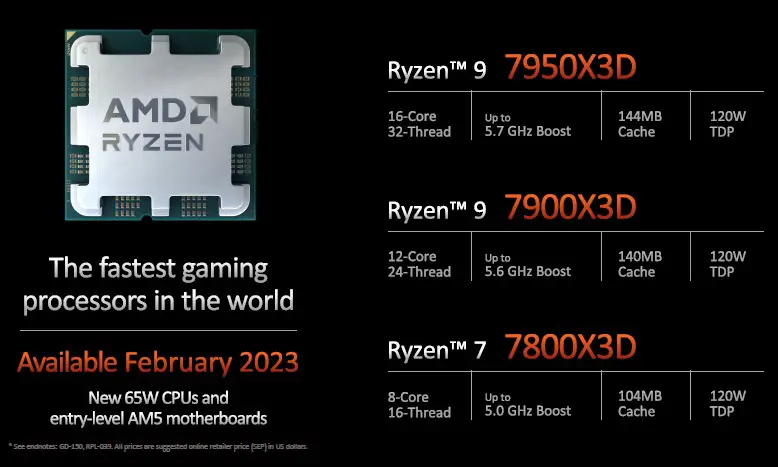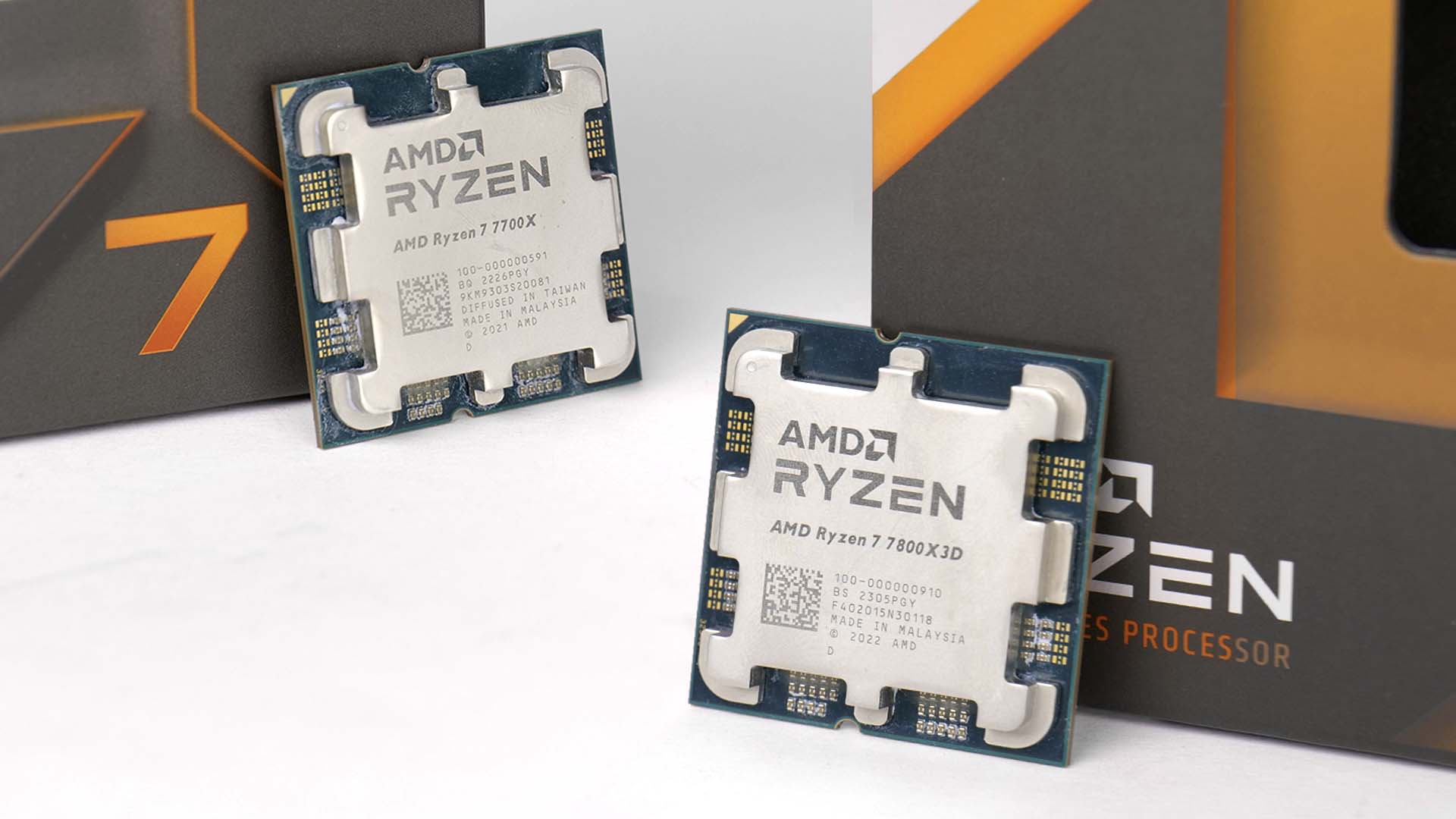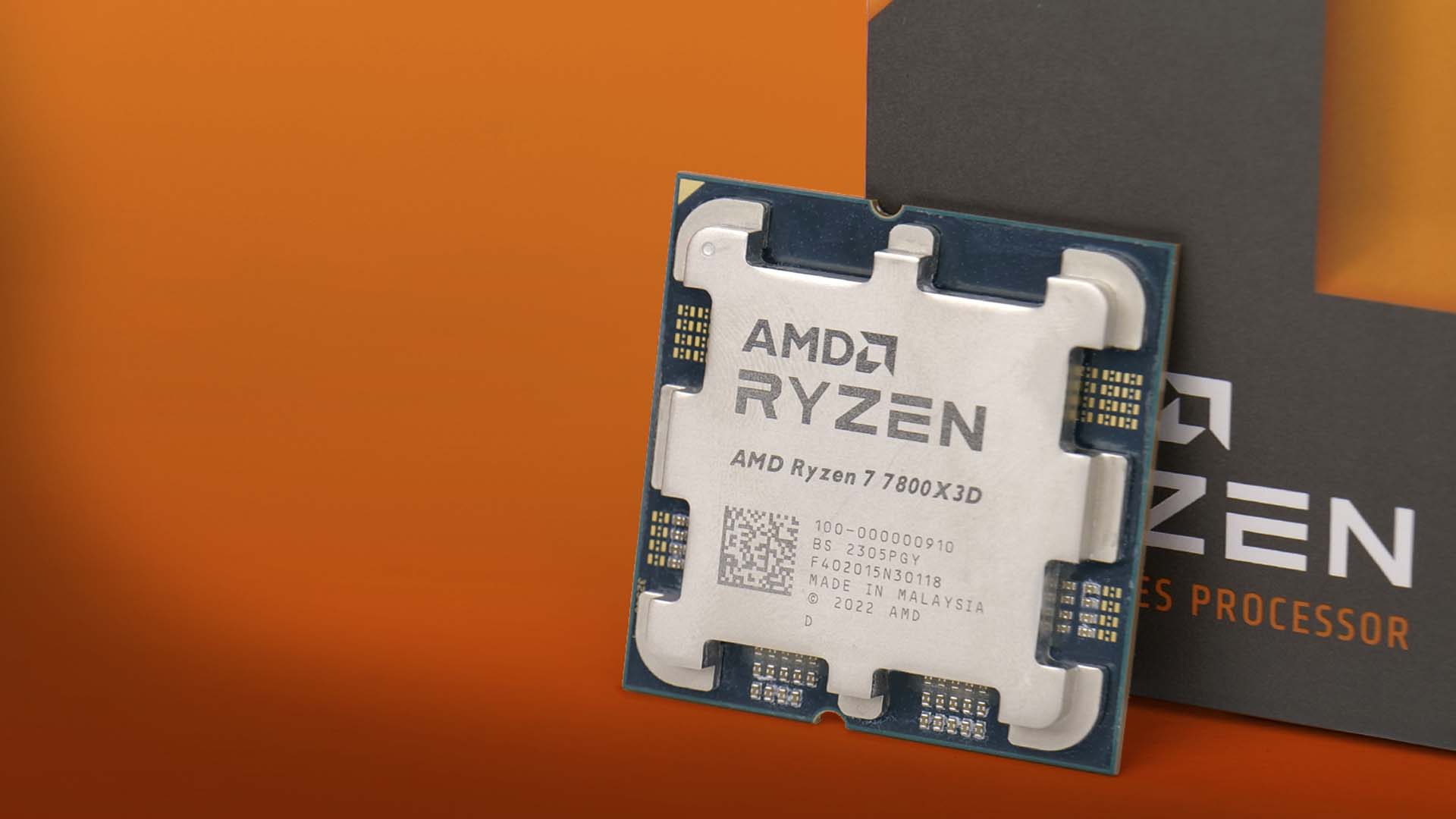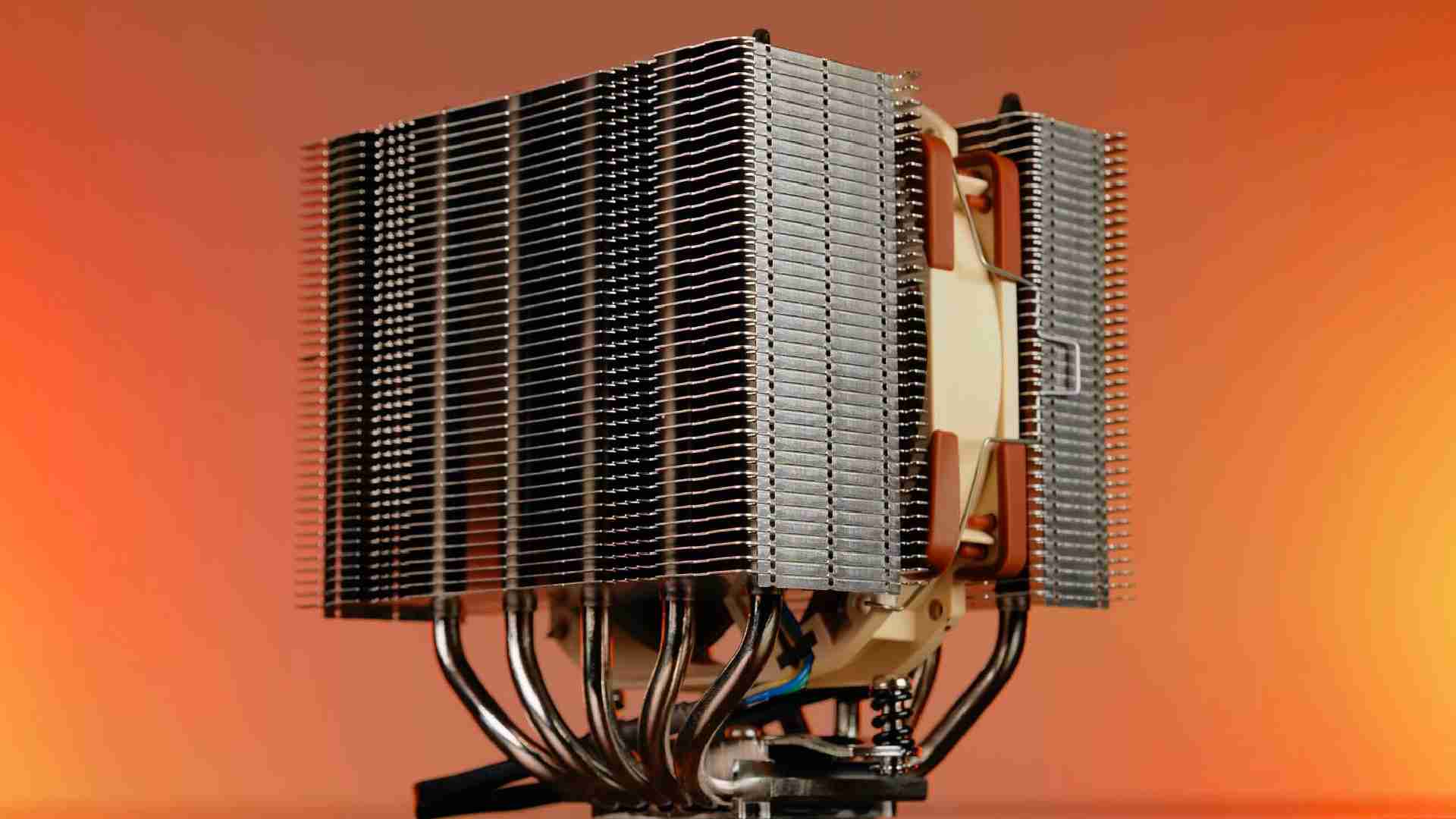Ryzen 7800x3D - The gaming CPU we need
Introduction
While AMDs initial Ryzen 7000 lineup was everything but boring, it was not quite the gaming hit that everybody expected. But as the platform matured, AMD combined the superior performance of Zen 4 with the 3D V-Cache previously seen on the 58003D! Let's take a closer look at the new AMD Ryzen 7800x3D and see if AMD managed to create the new Must-Have Gaming CPU of 2023!
Positive
- Excellent Gaming Performance
- DDR5 Support
- Integrated GPU
- Low Power Usage
- Low Heat dissipation
Neutral
- DDR5 only
Negative
- Doesn't beat the 7700x in work-related tasks
Ryzen 7000 X3D Lineup and Pricing

The original AMD Ryzen 7000 lineup was launched back in September 2022. At that time, 4x different CPUs were announced:
- Ryzen 9 7950X
- Ryzen 9 7900x
- Ryzen 7 7700X
- Ryzen 7600X
As part of this release, it was also the official announcement of AMDs new AM5 Socket found on motherboards featuring the new X670E, X670, B670E and B670 chipset.
Slightly beforehand, even before the release of Ryzen 7000, AMD released a special CPU specifically tailored with gaming in mind. Under the name 5800x3D, AMD introduced their 3d V-Cache technology. By stacking multiple layers on top of each other, AMD managed to greatly increase the amount of L3 cache present on the chip. A benefit that was mostly noticeable in gaming-like tasks.

Fast forward to mid- 2023 and AMD was finally ready to release a new set of Ryzen 7000 chips combining both technologies mentioned above:
- Ryzen 7800x3D
- Ryzen 7900x3D
- Ryzen 7950x3D
With the superior performance provided by Zen 4 and the added 3D V-Cache, AMD released a set of CPUs that are supposed to compete with other high-end chips in work-related tasks while utilizing the superior size of their L3 cache to enhance gaming performance greatly.
Down below you will find a list of the recently released Ryzen 7000 3D chips and their on-release MSRP.
| Name | Ryzen 7 7800x3D | Ryzen 7900x3D | Ryzen 7950x3D |
| Price | 449$ | 599$ | 699$ |
| Cores/Threads | 8/16 | 12/24 | 16/32 |
| Base Clock | 4.5GHz | 4.4GHz | 4.2GHz |
| Boost Clock | 5.0GHz | 5.6GHz | 5.7GHz |
| L3 Cache | 96MB | 32+96MB | 32+96Mb |
| TDP | 120W | 120W | 120W |
AM5 Socket

Compared to all previous Ryzen generations, the Ryzen 7000 lineup introduced the new AM5 Socket, an LGA- type. Therefore, the user has no other possibility than to exchange his motherboard once he wants to perform the upgrade.
As part of this upgrade, the user has 4 types of Chipsets to choose from: X670E, X670, B670E, and B670.
Although a completely new platform will already increase the initial upgrade cost, there's another aspect that needs to be taken into consideration. As AM5 is a DDR5-only platform, there is no way around replacing the Ram too.
Zen 4
Zen 4 is the architecture powering AMD's new Ryzen 7000 Lineup. Similarly to Zen 3, the new iteration still features up to 2 CCDs, however, this year it is built on TSMC's 5nm process.
Hidden under the generational number increase is also a doubling of L2 Cache, Up-to 15% IPC increase, DDR 5 support, PCIe Gen. 5 Support, and 5Ghz boost by default.
On the higher end, Zen 4 is limited by a maximum of 24 cores, a version that may come out at a later date.
A useful addition to Zen 4's capabilities compared to previous versions is the mandatory addition of AMD's RDNA 2 graphical unit. Although it has been emphasized multiple times by AMD, and we would confirm it, it is NOT a Game-ready GPU. Featuring only 2 cores at 2200Mhz, this miniature of a GPU is meant to be used solely to run a monitor.
Thanks to the addition of an iGPU, debugging a system has been made much easier.
3D V-Cache
Originally released with their 5800x3D, AMDs 3D V-Cahe is a technology that allows to stack multiple layers of cache on top of a CPU.
Although this technology is only applied to the "slowest" type of Cache, L3, the gains provided by the massive size increase are especially noticeable in gaming scenarios.

However, there are new limits created by adding this technology to an existing chip.
Due to a variety of reasons, chips using the new increased L3 cache will not be able to operate at speeds as high as non-3D counterparts. This downside may not affect everybody to the same degree. Even if the chips will be running slower by default, there are workloads that are actually benefitting more from the larger L3 cache, than they are affected by the lowered clock speed.
To not restrict the 3D V-Cache technology to a very specific type of use-case, AMD had another genius idea whilst implementing the 3D V-Cache into the higher core-count chips. Whilst the Ryzen 7800x uses only a single CCD design, it was inevitable to provide all of the one existing chiplet with their new type of cache.
For the higher core count chips like the 7900x and 7950x, AMD decided to implement the 3D V-Cache on only one of the two existing CCDs. This decision allows the CPU to perform very well in a variety of tasks. While one half of the chip will deliver superior performance in gaming-related tasks thanks to the additional L3 cache, while taking the hit of a lower core speed, the other half is a carbon copy of the non-3D version with similar performance as the regular chip. With half of the cores running at higher speeds, AMD was able to create a true hybrid CPU competing on the highest level for every type of workload.
Benchmark
Testing Equipment

The machine used to benchmark all of the available Ryzen 7000 chips consists of the following components:
- AORUS Master X670E Bios v.F5
- 2x G-Skill Trident Z5 Neo 6000MHz CL30 16Gb
- Samsung 980 Pro
- Zotac RTX 4090
- be quiet! Dark Power 1200W
Upon each benchmark run, the bios was reset to default whilst only enabling EXPO.
Power Usage and Temperature
Whilst running a Cinebench Multi-Thread run, the 7800x3D never used more than 84 Watts. Compared to every other Ryzen 7000 this is a significantly lower power usage which is simultaneously reflected in it's cooling needs.
Synthetic Benchmarks
Cinebench R23 Single Thread

In Cinebench R23 Single-Thread, the 7800x3D scored 1814 points. This 8% reduction compared to the original 7700x is a direct reflection of the lower clock speed cost coming from utilizing AMD's 3D-stacked cache.
Cinebench R23 Multi Thread

In Cinebench R23 Multi-Thread, the trend continues with the 7800x3D scoring 17906 points, another 8% downgrade compared to the 7700x.
Handbrake H264 -> H265

Transcoding a 5min H264 file into H265 took 641 seconds.
Corona Render

Using the new Corona render test, the 7800x3D was able to produce 6.2m rays per second.
Blender

In Blender, the 7800x3D managed to score 133, 86, and 64 points respectively in the Monster, Junkroom, and Classroom scenes.
Passmark

Running Passmark using the 7800x3D scored a total of 34754points on the CPU score.
CPU-Z Single

Similarly to Cinebench, CPU Z saw a similar decline in performance as the 7800x3D scored 694 points.
CPU-Z Multi

Allowing all cores to be used did not help with the score. At 7346 points, the decline going from 7700X to a 7800x3D was just as bad.
3DMark CPU Profile

As the last synthetic benchmark, we have 3DMark and their CPU Profile test. Using this test we can see how the performance of every CPU compares when using only a set number of threads while doubling the amount for each run.
Starting off at a 12% lower score compared to the 7700x, the result stayed relatively consistent with the 7800x3D ending the run at 14528 points.
Gaming Benchmarks
All of the game benchmarks were run on 1080p and the highest available settings (Anti-Aliasing excluded).
Shadow of the Tomb Raider

In Shadow of the tomb raider, the 7800x3d started to show its domination in gaming scenarios with every metric far in front of the 7700x.
Far Cry 6

In Far Cry 6, this trend continued. The 7800x3D won as the best CPU of its class.
Dota 2

Dota 2 saw some of the biggest benefits. While the -1% lows weren't quite as high, it averaged significantly higher compared to the comparable alternatives.
Rainbow Six Siege

For Rainbow Six Siege, the benefits might not be as enormous as on Dota 2, but for almost every metric, the 7800x3d scored significant points.
CS:GO

Although the 7800x3D managed to score significant points in every game scenario before, CS:GO is the perfect example that not every game benefits from more cache.
Compared to the 7700x, the 7800x3D did not win any medals. The only metrics that managed to stay higher were 1% and .1% lows.
Ryzen 7800x3d vs 7700x
Both being Ryzen 7000 7- chips with the same core count and the most comparable pricetag, we believe the most important comparison would be the 7700x vs 7800x3D.

While comparing the results of both CPUs directly, we were able to clearly observe the benefits and costs associated with AMD's 3D V-Cache technology.
In synthetic as well as rendering workloads (i.e working), there was no benefit observable at any moment. Single-core workloads might have taken only smaller hits, such as Cinebench or CPU-Z single thread. However, as soon as more cores are working on the task, the performance decrease from using a 7800x3D instead of a 7700x quickly became percentages upwards of 10%.
Averaging all the numbers generated by our non-gaming workloads showed that the 7800x3D was in fact about 8% behind the theoretically older and "weaker" model.
However, a 3D-Chips strength is not working, but gaming. Something that AMD clearly communicated beforehand.
As we ran every game using both chips, one after the other resulted in very positive results favoring the 7800x3D. The only outliner would be CS:GO, which clearly favors faster or more cores above more L3 Cache.
We also average the results generated during the game benchmarks without taking the .1% results into consideration as this metric generates highly volatile results.
On average, games saw 16% higher FPS counters while using a 7800x3D.
Summary

Considering how the 5800x3D performed back when it initially hit the shelves, the performance of the 7800x3D wasn't that much of a surprise.
No matter how we interpret the results, the 7800x3D is not a workhorse. At least not compared to the lower-priced 7700x.
However, where the 7800x3D shines, is gaming. Except for CS:GO, the 7800x3D managed to deliver between slightly and a lot more FPS. No matter if highs, lows, or averages, the 7800x3D always seemed to be one step ahead.
These results are definitely a direct result of the bigger L3 cache combined with the forcefully lower clock speed.
But there are also not immediately noticeable side effects of adopting this technology. Due to the lower clock speed, and although achieving higher FPS counters, the 7800x3D consumes close to half as much energy compared to its work-oriented counterpart. This then has two additional side effects, one being slightly less expensive electricity invoices, and another very important one: cooling requirement. Thanks to the 84 watts of total package power, we found there to be a variety of coolers capable of cooling down the 7800x3D. We may even go as far as to say that smaller mini-ITX-oriented coolers might be capable of keeping the beast tamed at all times.

The bottom line is: Compared to the 7700x, the 7800x3D is the better gaming CPU on average, it consumes less power and generates less heat.
All of the reasons listed above are what describe a good gaming CPU. And that is exactly what the 7800x3D is, a great gaming CPU.

Although there are other alternatives that may or may not be better under certain circumstances and while playing a certain game, on average, and whilst considering all factors, the 7800x3D is the best gaming CPU out of AMD's current Ryzen 7000 lineup.


Lazer3D LZX-8 Review
Lazer3D created a complete portfolio of beautiful Small Form Factor cases. The newest LZX-8 is no different. Lets take a clos
Read More
Montech Sky One ARGB Review
Meet the Montech Sky One. Out of Montechs premium line of hardware, their Sky One Case offers excellent Airflow paired with a
Read More
be quiet! Pure Loop 2 280
Using their newest Pure Wings 3 in 140mm, be quiet! tries to squeeze every inch of performance out of their Pure Loop 2 Serie
Read More
Noctua NH-D12L Review
Noctuas new NH-D12L promises the best of both worlds. Not only is it supposed to compete with industry-established models suc
Read More